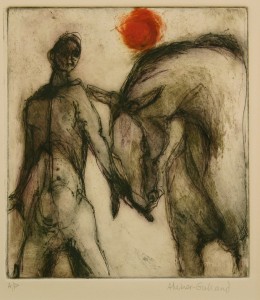
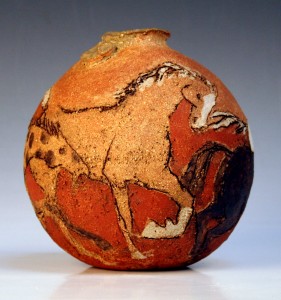
Washington-based artist Alison Milner Gulland works in a variety of media to voice her artistic imagination. Whilst her creations in oil, watercolour, collage, printing and ceramics offer different subjects and mastery, she establishes an inherent theme with lyrical and textural qualities and her rich earthy palette. Nicholas Toovey tells us more.
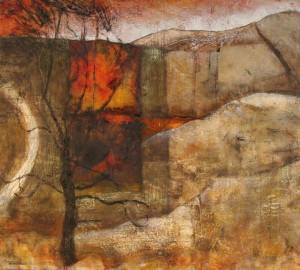
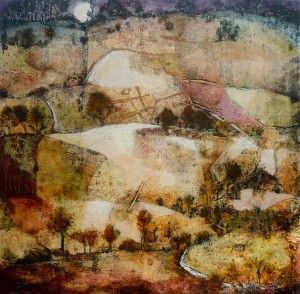
Alison has been drawing since she was old enough to hold a pencil, but did not intend to become an artist, despite her mother being an accomplished painter and her aunt being a talented botanical artist. It was a move of house and school that steered her away from her father’s scientific interests to an artistic path. It was under the tutorage of her Art Master, Edward Holmes, that she became inspired. Today, Alison feels fortunate to have studied under an encouraging teacher, still subconsciously adopting elements of his teachings, particularly in the use and mixing of colours. She continued her education in art, studying painting and theatre design at Birmingham College of Art and Craft and later printmaking at Brighton and Northbrook. More recently she has added another facet to her output in the form of ceramics, working intuitively this is, she admits, learning by trial and error.
She has taught art in several counties, but Alison feels ‘Sussex chose her’; bringing up her family with her husband in the county and living in a handful of picturesque Downland villages. Does Sussex inspire her? Without question, both in her palette and often with subject matter. She has owned horses since being a teenager and until three years ago, regularly rode up the Downs, quickly discovering that she could not persuade her horse to stand still for long enough to make sketches. Instead Alison committed the movement of the downs and that of the horse to memory. From the elevated position she could see the sweeping chalk curves, with its ancient trackways, rolling hills and far-reaching views, later transferring these thoughts and images to paper and canvas.



Her studio nestles at the foot of the South Downs in the small village of Washington. Inside is a well-organized chaos, framed works are hung wherever wall-space permits or stacked on the floor. After being greeted by the family’s 15 year old pet dog, Harriet, and navigating through a maze of pictures, mounting materials and packaging you come to the main work area of the cottage studio. Here architect’s chests conceal numerous unframed prints, stacked on top of these are further prints, oils on canvas and works in progress, beneath works drying on a washing line. Occasionally the sound of nearby chickens, geese, guinea fowl or sheep are heard from outside. To fresh eyes it would be difficult to believe that disaster had recently struck this room, but drawers are now half-full or containing materials instead of finished works. It has only been a few years since a torrent of water, reaching over a foot high, swept through the studio. This half-hour of devastation resulted in nine bonfires of ruined art. Numerous works on paper and canvas sentenced to the pyre, pictures that on occasion dated back to her student years. Some pictures were partially salvageable and Alison has now reworked many fragments of previous pieces into new reinterpretations in collage and on canvas.
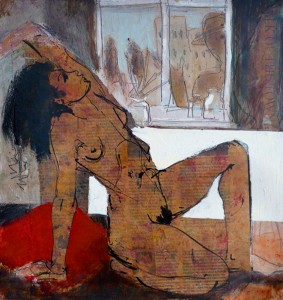
Negotiating the livestock and braving the elements gains access to a separate studio dedicated to her work in ceramics. A colder but brighter and neater space, inherently slightly dusty from the powders, glazes and clays used to create the work. Along two walls are shelves displaying recent vessels, mostly figurative or musically inspired, but with a few trial abstractive landscape designs scattered amongst them.
She has exhibited her work extensively in Great Britain, including a highly successful exhibition featuring a collection of Russian inspired art in the ScotlandRussiaForum during the Edinburgh Festival last year. Alison also makes regular appearances in the annual arts festivals of Arundel, Brighton, Oxford, and Washington. Work by Alison has been purchased by New College, Oxford and Worthing Museum and Art Gallery for their permanent collections, with other works in private collections around the world.
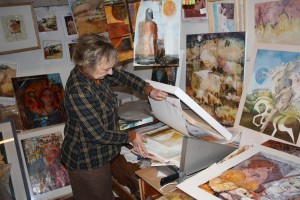
Alison is also an active member of the Sussex Watercolour Society and this year will be exhibiting with other members in Henfield and at the Hop Gallery in Lewes. She has also recently been invited to exhibit with the Society of Graphic Fine Artists in London and often shows with the Southern Ceramics Group.
Alison’s paintings, prints and ceramics all reflect the beautiful rural countryside surrounding her studio, infused with classical, mythical or natural inspirations. The variety in media and style means her art fits into almost all interiors, from country cottages to feature walls in contemporary spaces. At first glance her work is accessible and uncomplicated, but over time, the layers, subtle details and evolving depths of the art come to the fore, highlighting the talent of this artist.
Nicholas’ article was originally published in Sussex Life magazine in April 2011.